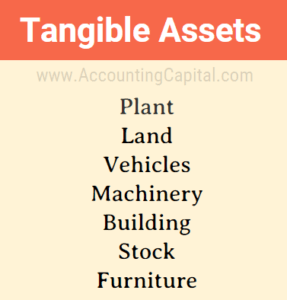Meaning of Tangible Assets
Assets that have a physical existence and can be touched and felt are called tangible assets. They consist of both fixed and current assets, they are always at risk of destruction from natural incidents, theft, accidents, etc. A business would usually insure them to safeguard themselves against unseen future events.
Such resources can be readily used as collateral against secured loans and may be sold to bring in cash in times of emergency. Unlike intangible assets, they can easily be stored and accumulated as well.
Examples of Tangible Assets
It’s easy to determine useful life for such physical assets. Examples of tangible assets are plant, machinery, building, stock, cash, furniture, etc.
Types of Tangible Assets
- Current Assets – They are assets that are held for a short period mainly within a single accounting cycle of a business. Benefits of current assets are expected to flow for a period equal to or less than a year.
Examples – Cash, bank, stock, etc.
- Fixed Assets – They are assets that are held for a long term and benefits of which are derived for multiple accounting periods. They can’t be converted to cash immediately.
Examples – Land, plant, machinery, vehicles, etc.
Fixed assets are charged with depreciation due to normal usage, wear and tear, new technology, or unfavourable market conditions.
Short Quiz for Self-Evaluation
Revision & Highlights Short Video
Highly Recommended!!
Do not miss our 1-minute revision video. This will help you quickly revise and memorize the topic forever. Try it :)
>Related Long Quiz for Practice Quiz 32 – Tangible Assets
>Read Intangible Assets

